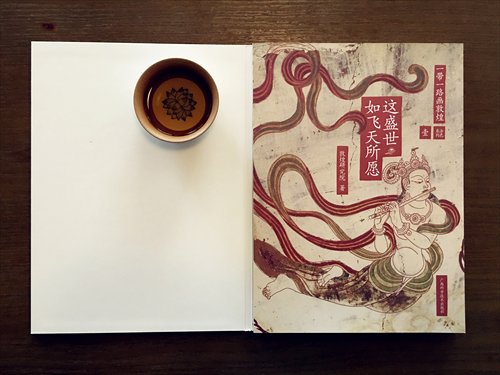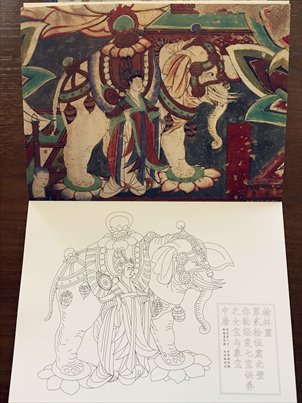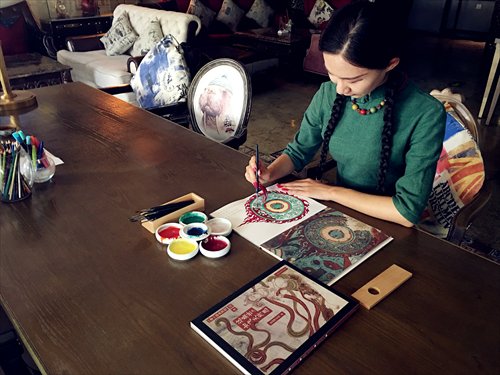
The cover of Coloring for Dunhuang Frescoes (Photo/Courtesy of Yuan Xiaocha)

Pages from Coloring for Dunhuang Frescoes (Photo/Courtesy of Yuan Xiaocha)

Yuan Xiaocha colors in a page from Coloring for Dunhuang Frescoes (Photo/Courtesy of Yuan Xiaocha)
The three-volume series Coloring for Dunhuang Frescoes, the first official coloring book produced by the Dunhuang Academy China, debuted in bookstores on Friday.
"We hope our readers can access the mysteries of Dunhuang culture and enjoy an imaginative Eastern experience in a relaxing way," a quote from Wang Xudong, president of the Dunhuang Academy China, says on the back of the book.
The caves containing numerous Buddhist wall paintings and statues in Dunhuang, Gansu Province, are protected world cultural heritage sites. The art within these caves are national treasures, the copyrights of which belong to the Dunhuang Academy China. The first book the academy has published for entertainment instead of research, it contains tracings of numerous frescoes and calligraphy works for readers to color in at their pleasure.
"The book contains many national treasures that you wouldn't be able to see if you purchased a ticket to visit the caves," the book's editor Yuan Xiaocha told the Global Times via e-mail.
Taking flying Apsaras, female water and cloud spirits from Buddhist mythology, as its theme, the semi-handmade book features full-color examples of selected portions of six of Dunhuang's most famous frescoes, accompanied by the name and date of the painting in the left-hand corner. Opening the book, these examples are on the right page, while the page opposite contains stories and background information about the figures depicted. A page of tracing paper separating an explanation from a fresco is provided so that readers can try their hand at tracing the frescoes and then coloring them in.
In addition, 25 other paintings are included, with the original on one side and a black and white tracing of said painting on the other so readers may color it in as they like.
"We hope this design can make readers feel more involved since what they are coloring is not just a 3-year-old design from the coloring book Secret Garden, but an ancient image that dates back to more than 1650 years ago," Yuan explained.
The book also includes a tracing of a rare Diamond Sutra calligraphy work from the Tang Dynasty (618-907) that can also be colored in by readers.
Long hard road
Due to the complex craftsmanship involved in making each book, only 10,000 copies were produced. These sold out in less than a week after the book hit store shelves. To accompany the book's publication, Yuan posted her editor's notes on her personal webpage on media review site douban.com.
According to Yuan's notes, involving a number of "breakdowns, roadblocks, tests, quarrels and hardships," the project took 203 days to complete.
"Responsibility is a really terrible thing," Yuan wrote.
She told the Global Times that she was under great pressure "because these (frescoes) relics from our ancestors have attracted so much attention, we were not allowed to make a single tiny mistake.
"We had to be as cautious as possible. For instance, every photograph had to go through a six-step verification and approval process. Even the annotations were first drafted by Dunhuang scholars. Although this book was aimed at the general public, it has gone through a rigourous and professional process."
Cultural foundations
With the rise and fall of the coloring trend brought about by adult-oriented coloring book Secret Garden, Chinese publishers have turned to the promotion of traditional culture in their search for original coloring book themes. One of the first steps in this direction was taken by the Forbidden City Publishing House, which launched the Painting the Forbidden City series.
In the afterword of the book Wang writes, "Even if we can protect and preserve these caves, we will still lose our cultural roots if young Chinese no longer understand the civilization of their ancestors."
The book sells for 48 yuan ($7), which Yuan compares to the price of a cabbage, and so is something that anyone can afford.
She also agrees with Wang. "The Japanese, British and French say that although Dunhuang is in China, the most important Dunhuang research is being carried out in their countries. As a post-1990 generation editor, I also hope young people can learn more about our culture. Without cultural roots we cannot have our own creative designs."


















































